Subterranean Termites
Termites, commonly referred to as “white ants” or “white cockroaches” in Mandarin and Malay, are more closely related to cockroaches than ants. They are responsible for 90% of all termite-related damage.
Subterranean termites, scientifically known as Coptotermes Gestroi, are one of the most destructive pests of wood in Asia. They cause significant damage annually and can severely harm a family’s most valuable possession in their home. These termites reside in colonies underground and possess specialized castes for specific colony tasks. Their society comprises three classes: Workers, Soldiers, and Swarmers. The workers are responsible for foraging, caring for the young, construction and repair, and defending the colony.
As one of the three types commonly found in Singapore, subterranean termites nest in soil and search for food, typically cellulose found in wood and timber products, by travelling through walls, steel, and other cracks and crevices. This can lead to damage to electrical wiring and conduits. While termites play an ecological role in breaking down fallen trees in their natural environment, they can cause significant damage to human structures and furniture, resulting in costly repairs and replacements.
Treatment for Subterranean Termites:
Treatment for Subterranean Termites:
- Termite Baiting
- Spot Treatment
- Soil Treatment
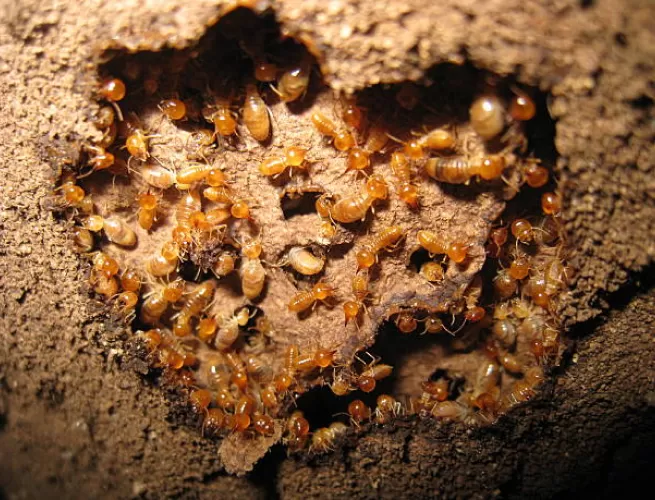
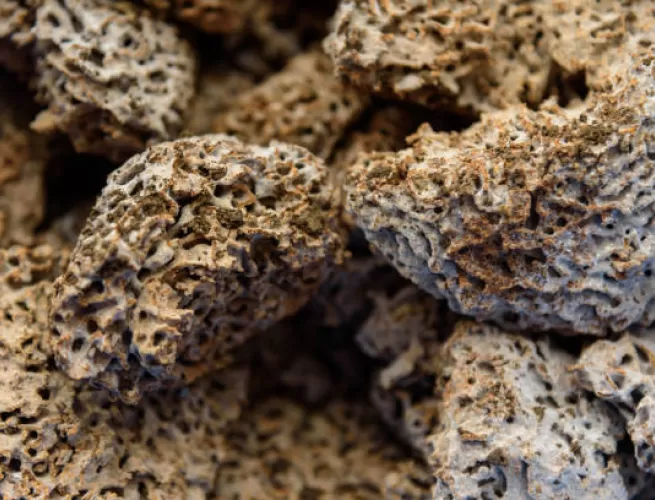
How do you know you have a termite infestation?
When identifying subterranean termite infestation, the primary indicator to look for is the mud-shelter tubes they construct on walls and panels. These tubes provide a safe passage for the termites to travel from their underground nest to the timber structure they feed on. In some cases, you may hear clicking noises caused by soldier termites tapping their large jaws on the wood, which signifies danger to the rest of the colony. If you can listen to these knocks, it strongly indicates that the infestation is severe, as soldiers make up less than 10% of the population. However, the presence of subterranean termites is often only detected after extensive damage has already occurred.
Signs of Subterranean Termites Infestations
If you see any sign mentioned below, it’s always best to consult a professional pest control specialist to determine if there is an infestation.
Several signs can indicate a subterranean termite infestation. Some of the most common include:
- Mud-shelter tubes: These are small, pencil-sized tubes made of mud and saliva that termites construct on walls and other surfaces to protect themselves as they travel from their underground nest to the wood they feed on.
- Clicking sounds: In some cases, you may hear clicking noises caused by soldier termites tapping their large jaws on the wood, which is a sign of danger to the rest of the colony.
- Damaged wood: Subterranean termites feed on wood and can cause extensive damage to the structure of a building. Signs of damage may include sagging floors, doors that won’t close properly, and hollow-sounding wood.
- Swarmers: In the spring or fall, subterranean termites will send out reproductives, or swarmers, which are winged termites that are attracted to light.
- Discarded wings: After swarming, termites will toss their wings, which can be found near windows and doors.
- Live termites: Subterranean termites are small, creamy-white insects about 1/4 inch long.
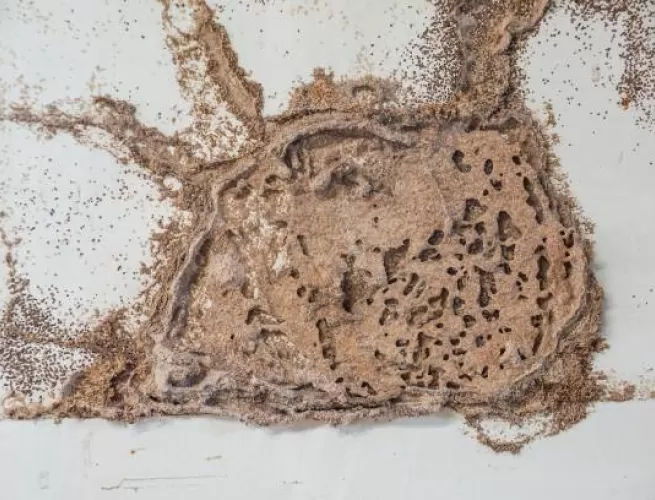
Suspect a termite infestation in your property?
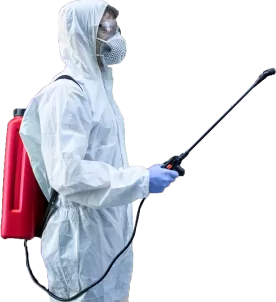
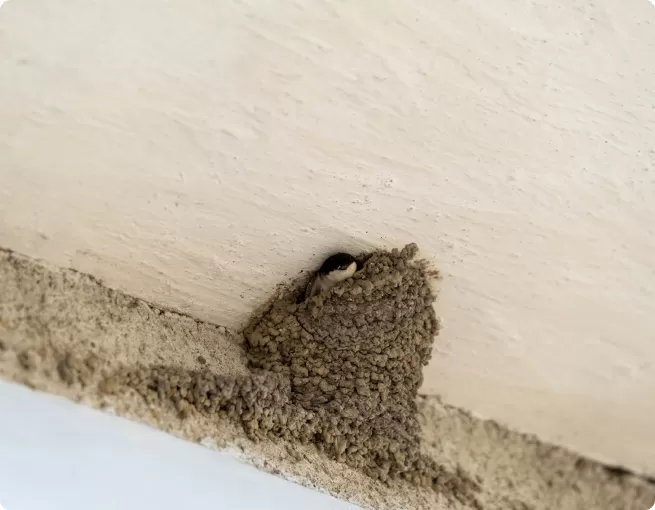
How can you protect your property from Subterranean Termites?
Spraying a can of aerosol insecticide will only kill the soldier and worker termites scavenging outside their nest. Furthermore, as a mature nest has an average of 1 million inhabitants, you are unlikely to eliminate the rest of the colony. Instead, you may force them to reappear in another place where you cannot detect their presence, and the damage will continue undisturbed until it is too late!
There are several steps you can take to protect your property from subterranean termites:
Regularly inspect your property for signs of termite infestation, such as mud-shelter tubes, damaged wood, and swarms of winged termites.Remove any potential food sources: Termites are attracted to wood, so it’s essential to remove any potential food sources, such as firewood, scrap lumber, and cardboard, that are stored near the foundation of your home.
Regularly inspect your property for signs of termite infestation, such as mud-shelter tubes, damaged wood, and swarms of winged termites.Remove any potential food sources: Termites are attracted to wood, so it’s essential to remove any potential food sources, such as firewood, scrap lumber, and cardboard, that are stored near the foundation of your home.
Regularly inspect your property for signs of termite infestation, such as mud-shelter tubes, damaged wood, and swarms of winged termites.Remove any potential food sources: Termites are attracted to wood, so it’s essential to remove any potential food sources, such as firewood, scrap lumber, and cardboard, that are stored near the foundation of your home.
Regularly inspect your property for signs of termite infestation, such as mud-shelter tubes, damaged wood, and swarms of winged termites.Remove any potential food sources: Termites are attracted to wood, so it’s essential to remove any potential food sources, such as firewood, scrap lumber, and cardboard, that are stored near the foundation of your home.
Regularly inspect your property for signs of termite infestation, such as mud-shelter tubes, damaged wood, and swarms of winged termites.Remove any potential food sources: Termites are attracted to wood, so it’s essential to remove any potential food sources, such as firewood, scrap lumber, and cardboard, that are stored near the foundation of your home.
It’s important to note that it’s best to consult a professional pest control specialist to determine the best course of action and ensure the treatment is done correctly and safely.
Under a franchise arrangement with TermiCam Australia in 2002, Aardwolf Pestkare is the first company in Asia to employ Thermal Imaging to detect Termite Infestation.
A piece of equipment will remain just a tool unless it is handled by qualified professionals. Aardwolf Pestkare is proud that all its Thermographers are trained in Australia and certified by the Australian Institute for Non-Destructive Testing (AINDT).
This explains why Aardwolf Pestkare’s Termite Management Programme enjoys an estimated 98% success in detecting Termite presence and entry points accurately and promptly, so that effective treatment can be carried out before further damage is caused.
This is what the highly sophisticated TermiCam sees:
As proof of our reliability, Aardwolf Pestkare is the first pest management company in Singapore to offer financial protection against timber damage caused by Subterranean Termites.
Frequently Asked Questions (FAQ) - Pest Control in Singapore
Subterranean termites damage buildings by feeding on the cellulose found in wood. They tunnel through the wood, weakening the structure and causing it to become unstable. They can also cause cosmetic damage by creating small holes in the wood.
Subterranean termites damage buildings by feeding on the cellulose found in wood. They tunnel through the wood, weakening the structure and causing it to become unstable. They can also cause cosmetic damage by creating small holes in the wood.
Subterranean termites damage buildings by feeding on the cellulose found in wood. They tunnel through the wood, weakening the structure and causing it to become unstable. They can also cause cosmetic damage by creating small holes in the wood.
Subterranean termites damage buildings by feeding on the cellulose found in wood. They tunnel through the wood, weakening the structure and causing it to become unstable. They can also cause cosmetic damage by creating small holes in the wood.
Subterranean termites damage buildings by feeding on the cellulose found in wood. They tunnel through the wood, weakening the structure and causing it to become unstable. They can also cause cosmetic damage by creating small holes in the wood.
